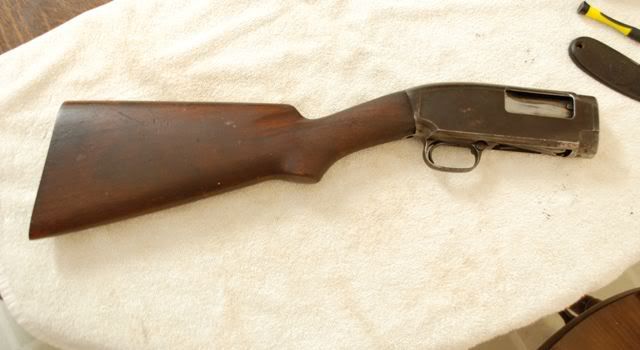So I'm about to refinish an old shotgun stock. I have never done it before and would love to talk to someone who has to make sure I have my process down and discuss a few things and learn as much as I can before I begin. Or better yet if someone had some experience in the Waco area I'd love to sit down and talk. Shoot me a pm if you can help with some knowledge and I'll give you a call- I will post before and after pics and I'm having the receiver and barrel cerakoted so the hope is it looks like a brand new gun. Gun is a 1960's Universal Auto Wing by the way. Thanks guys.
Announcement
Collapse
No announcement yet.
Refinishing Gun Stock
Collapse
X
-
1). clean the stock with denatured alcohol to remove gun oil
2) sand it with 150 grit until all of the old finish is off
3) blow all of the saw dust off with compressed air
4) apply about ten coats of TruOil letting it completely dry between coats
5) wetsand with 400 grit Wet R Dry sandpaper
6) put on five to ten more coats of finish
keep repeating the process until you have the depth of finish desired. Finish sand with 1000 grit Wet R Dry. Buff it out with a low speed buffer or variable speed drill with a cotton buffing wheel. Do not stay in one spot or you will burn through the finish and have to sand and start over. Finish the job with a good waxing.
-
Would varnish remover work as well to remove old finish or would denatured alcohol be better? And have you guys used boiled linseed oil or is that not a good way to go? And how about the checkering? I was just planning on not sanding checkering at all because I obviously don't want to sand that down- just removing the finish from the checkering and reapplying. Thanks.
Comment
-
Be careful with varnish or paint removal on plastic spacers as it will destroy them. With checkering, I use an old toothbrush with paint remover - The gel-type works best.
After stain + 2 coats of Tru-Oil. I start at 400 grit and work my way to 1200 grit wet sanding the Tru-Oil into the pores. This process takes @ 4 weeks but the finish is very durable.
Comment
-
I use a similar process sanding in the tru-oil, but by the timeI get from one end of the stock to the other, I can start over at the beginning and do the next coat. I can put multiple coats on in a day. The only thing that does take time is letting it hang and age for a month after the last coat is on.Originally posted by Patriot-2000 View PostBe careful with varnish or paint removal on plastic spacers as it will destroy them. With checkering, I use an old toothbrush with paint remover - The gel-type works best.
After stain + 2 coats of Tru-Oil. I start at 400 grit and work my way to 1200 grit wet sanding the Tru-Oil into the pores. This process takes @ 4 weeks but the finish is very durable.
Comment
-
if you nave some gouges, and think you want them out.
heat a iron.. have a small bowl of water, and a small towel...dampen the rag, lay the rag over the ding small gouge, and hit it w/ a iron.. 20+ seconds..and then let it cool, it will cause the wood to rise, and allow it to be sanded flat also..
Comment



Comment